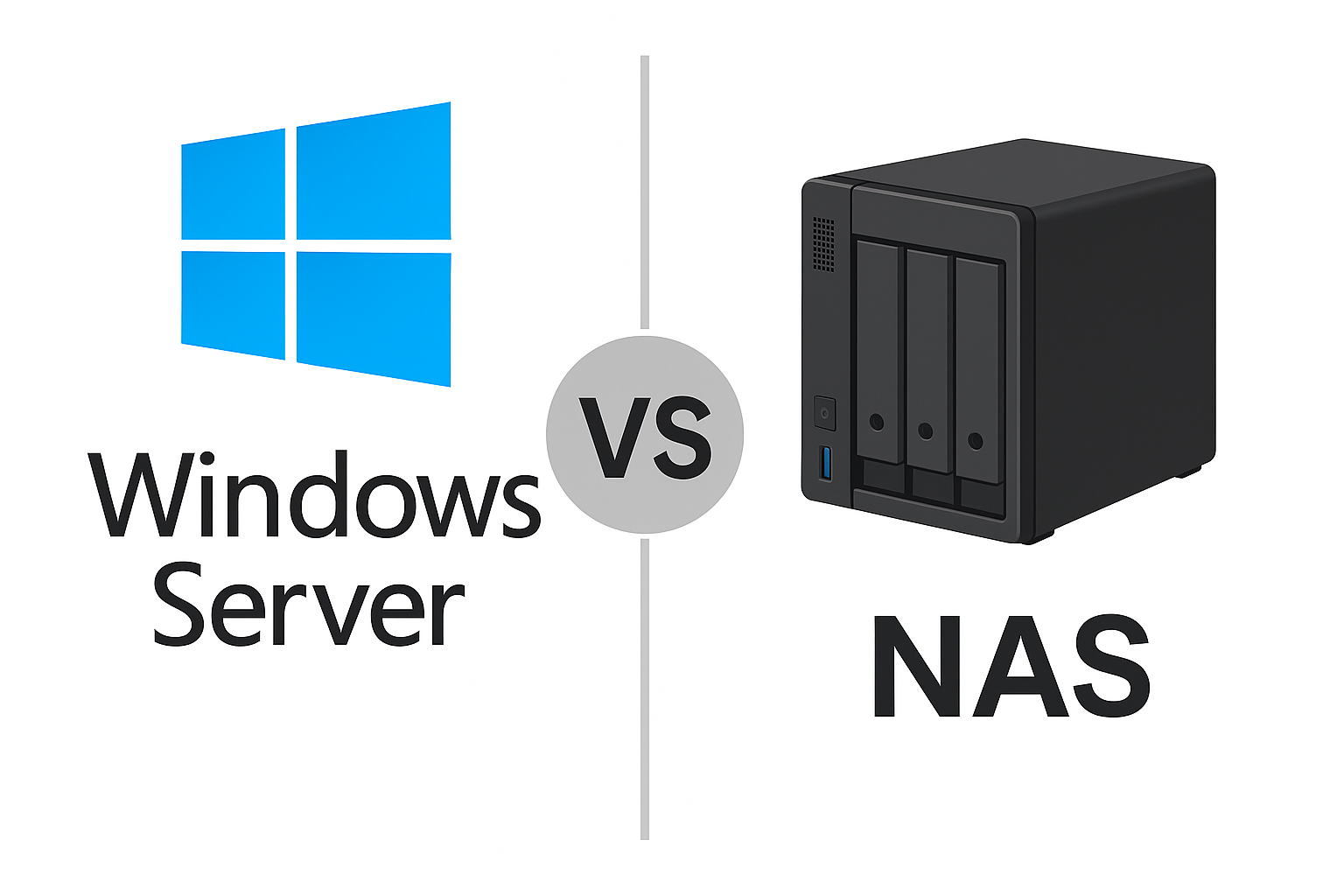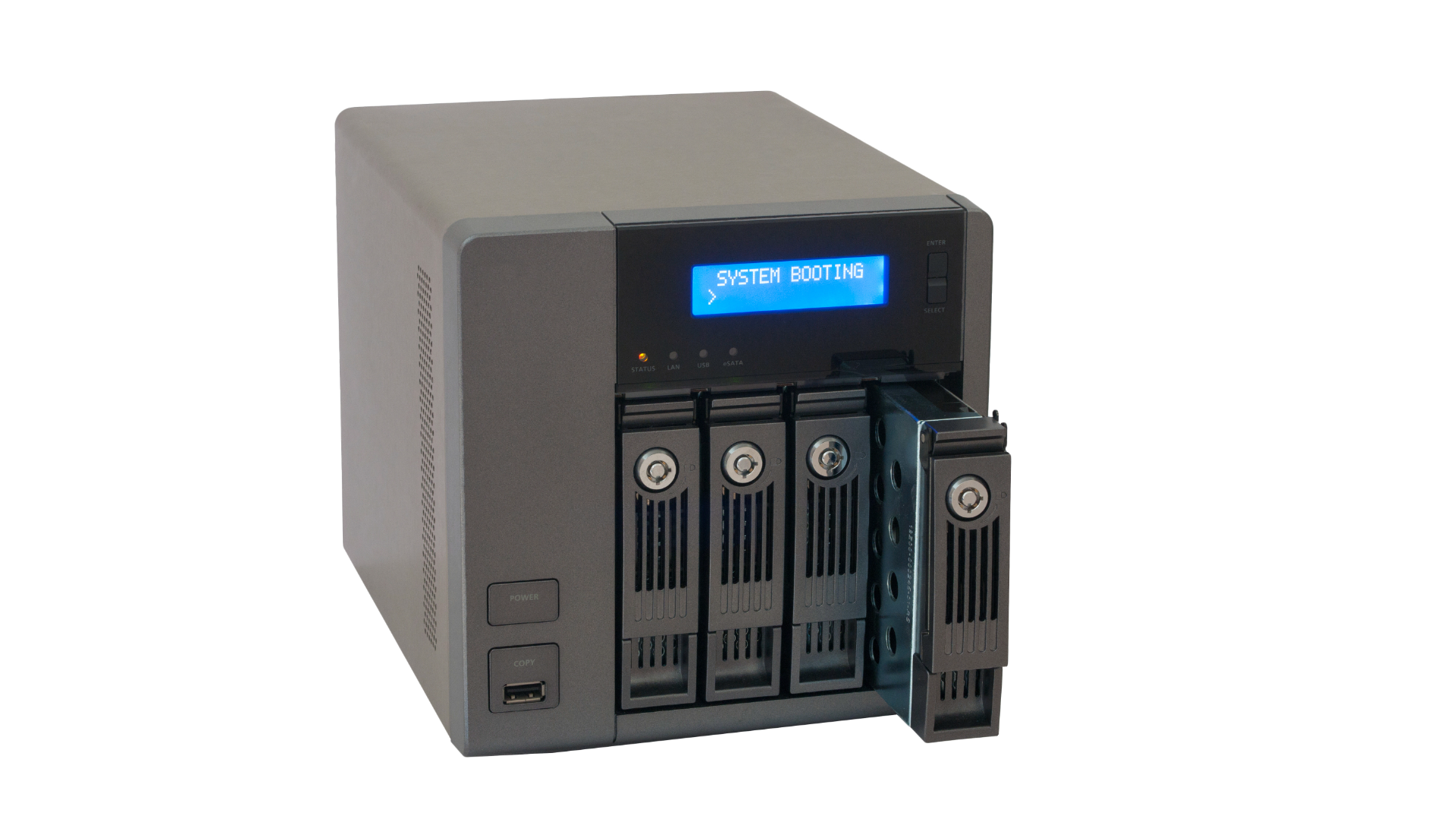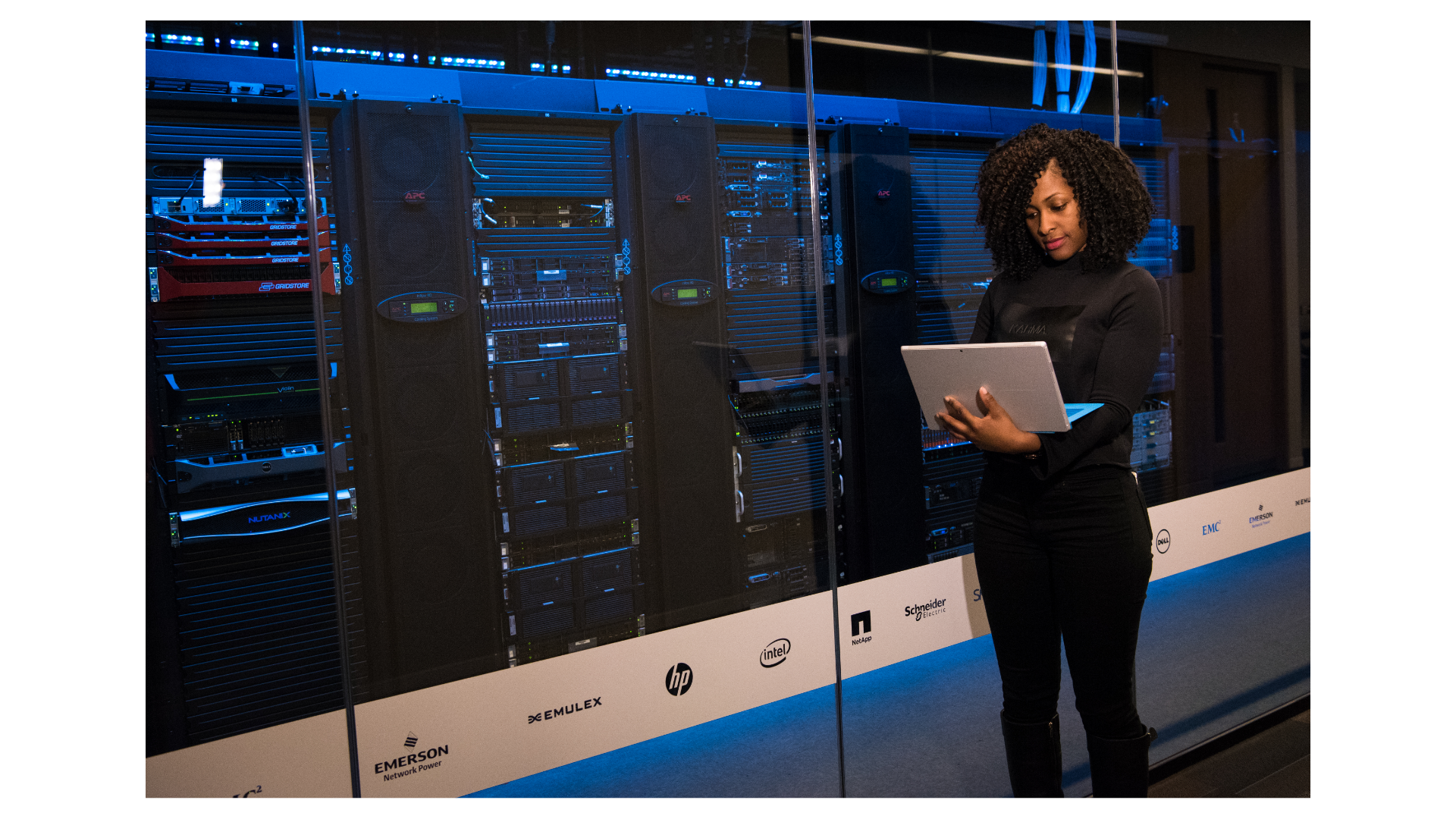Windows Server vs NAS : choisir la solution la plus adaptée à vos besoins de stockage

Vous vous demandez si vous devez choisir Serveur Windows ou un NAS Pour vos besoins de stockage ? Windows Server et NAS font partie des solutions les plus courantes pour le stockage de données. Nous comparons ci-dessous Windows Server et NAS pour vous aider à choisir la solution la mieux adaptée à vos besoins. Chaque option présente ses propres avantages, et les comprendre vous permettra de faire un choix éclairé.
Points clés à retenir
- Un serveur Windows offre des fonctionnalités avancées et des capacités étendues adaptées aux environnements d’entreprise, notamment la virtualisation et la gestion centralisée des utilisateurs via Active Directory.
- Les périphériques NAS offrent des solutions de stockage économiques et conviviales, idéales pour les petites entreprises et les particuliers, bénéficiant d'un déploiement rapide et de coûts récurrents réduits. Ils offrent également une solution plus économique que les configurations Windows Server traditionnelles, en réduisant les coûts d'achat initiaux et en éliminant les frais de licence récurrents par utilisateur.
- Lorsque vous choisissez entre Windows Server et NAS, tenez compte de facteurs tels que le budget, l’évolutivité, l’expertise technique, la vitesse de déploiement et les besoins spécifiques des applications pour prendre une décision éclairée.
Comprendre Windows Server

Un serveur Windows dédié offre un système d'exploitation fiable et polyvalent, conçu pour garantir une disponibilité continue du réseau et garantir l'accessibilité et la gestion des ressources à tout moment. La taille de ces serveurs varie, allant d'unités de bureau compactes à des racks complexes remplis de matériel, offrant de nombreuses options de configuration pour répondre aux besoins spécifiques de chaque entreprise.
Windows Server est réputé pour ses fonctionnalités sophistiquées et ses capacités d'intégration fluides, ce qui le rend très recherché en entreprise. Il prend en charge une large gamme d'applications et de services, notamment le partage de fichiers et la virtualisation, tout en offrant une grande adaptabilité grâce à des options de personnalisation adaptées à des fonctions métier spécifiques. Windows Server peut également être configuré avec différents logiciels pour optimiser ses fonctionnalités.
Il est essentiel de comprendre les attributs essentiels, les stratégies de déploiement et les cas d’utilisation courants lorsque l’on considère comment et où Windows Server s’intègre dans votre entreprise.
Principales fonctionnalités de Windows Server
Windows Server se distingue par son intégration de Active Directory, qui centralise la gestion et l'authentification des utilisateurs. Ce système permet aux administrateurs de gérer l'accès aux ressources du serveur tout en maintenant des normes de sécurité élevées. En utilisant des autorisations granulaires sur les fichiers et les répertoires, Windows Server garantit que l'accessibilité des données répond précisément aux besoins individuels des différents utilisateurs et unités organisationnelles. Un serveur de fichiers offre généralement un matériel plus puissant et des fonctionnalités supérieures à celles des périphériques NAS.
Une autre fonctionnalité clé offerte par Windows Server est la virtualisation via Hyper-V, qui permet la création de machines virtuelles dédiées aux serveurs de fichiers. Cela optimise l'efficacité des ressources tout en permettant une gestion plus adaptable des charges de travail. Superviser Windows Server requiert une expertise technique pointue, essentielle à la mise en place de mesures de sécurité étendues et de configurations complexes.
Dans l’ensemble, compte tenu de ses fonctionnalités sophistiquées adaptées à la gestion de tâches complexes centrées sur les données à grande échelle, Windows Server est inestimable pour les entreprises cherchant à améliorer leur architecture informatique.
Déploiement et configuration
La configuration de Windows Server nécessite une infrastructure complexe et sur mesure, exigeant un savoir-faire informatique spécialisé. La conception typique des serveurs de fichiers intègre souvent une architecture x86-64 ou SPARC, et offre une grande flexibilité pour sélectionner des éléments tels que les contrôleurs de disque. contrôleurs RAID, ainsi que des disques durs et des SSD pour créer un serveur de fichiers sur mesure. Pour une efficacité et des performances accrues, il est conseillé d'opter pour des types de stockage sur disque spécifiques, tels que les disques rotatifs SAS ou les SSD.
Les serveurs de fichiers peuvent être assemblés dans différentes structures physiques, telles que des tours ou des racks. Le protocole SMB est souvent utilisé pour partager des fichiers sur un réseau et établir des partages de fichiers. Configurer l'équilibrage de charge au sein d'un cluster de serveurs de fichiers peut améliorer les performances et la fiabilité en répartissant uniformément les charges de travail entre les serveurs.
Effectuer une maintenance de routine sur votre serveur est essentiel pour maintenir sa capacité opérationnelle maximale et garantir des performances fiables au fil du temps.
Cas d'utilisation typiques
Windows Server est fréquemment utilisé en entreprise grâce à ses fonctionnalités avancées, capables de gérer un afflux important d'utilisateurs et de nombreux transferts de données. Il offre les outils et l'infrastructure essentiels à une gestion efficace de l'analyse et du stockage de Big Data, notamment dans les situations impliquant une administration de données à grande échelle. Idéalement, Windows Server est équipé d'un matériel puissant pour gérer des tâches complexes centrées sur les données.
Windows Server s'avère être la solution idéale pour les configurations réseau complexes grâce à sa capacité à gérer diverses configurations réseau et un large éventail d'applications. Le choix d'une solution de stockage adaptée est essentiel pour une gestion efficace des données en entreprise.
Qu'est-ce qu'un périphérique NAS ?

Un stockage en réseau (NAS) s'apparente à un ordinateur dédié au stockage et au partage de fichiers sur un réseau. Ces périphériques NAS facilitent l'accès et l'échange simultanés de fichiers entre plusieurs utilisateurs, répondant ainsi efficacement aux besoins de stockage et de partage de fichiers.
Réputés pour leur prix abordable et leur convivialité, les NAS sont particulièrement attractifs pour les petites entreprises et les particuliers. Généralement proposés sous forme de systèmes pré-assemblés et prêts à l'emploi, ils garantissent une installation et une maintenance simplifiées pour un fonctionnement plug-and-play. Les NAS peuvent également créer automatiquement des sauvegardes locales et s'intégrer à un logiciel de sauvegarde pour une protection renforcée des données.
Principales fonctionnalités des périphériques NAS
Les périphériques NAS offrent une solution pratique permettant aux utilisateurs d'accéder facilement à de vastes volumes de données. Ils permettent d'intégrer des téraoctets de stockage à leur réseau en reliant des dossiers comme des lecteurs réseau sur des ordinateurs locaux. Leur conception privilégie la simplicité d'utilisation, permettant aux personnes ayant des connaissances techniques limitées de les utiliser efficacement. Les systèmes NAS sont généralement dotés d'interfaces graphiques conviviales qui simplifient considérablement des tâches telles que la gestion des autorisations des utilisateurs et le partage de fichiers.
Associés à Windows Server, les périphériques NAS offrent une gestion simplifiée et intuitive, s'adaptant ainsi à la situation des utilisateurs sans expertise technique approfondie. Les solutions NAS sont donc particulièrement avantageuses pour les petites entreprises souhaitant étendre leurs capacités à moindre coût, grâce à leur évolutivité et à leurs avantages financiers par rapport aux serveurs traditionnels. Leur portabilité et leur rentabilité en font également des solutions particulièrement avantageuses pour les petites entreprises.
La nature accessible des interfaces des périphériques NAS, associée à des procédures de maintenance sans tracas, les positionne comme des options très adaptées aux petites entreprises ou à un usage personnel où des services de stockage de fichiers accessibles sont nécessaires à partir d'une configuration de serveur NAS.
Installation et gestion
Les utilisateurs recherchant un déploiement rapide trouvent la configuration d'un NAS relativement simple, souvent réalisée en quelques minutes. En revanche, la mise en service de Windows Server peut nécessiter plusieurs heures avant qu'il ne soit pleinement opérationnel. De plus, le logiciel NAS est généralement inclus avec le NAS, ce qui permet de réaliser des économies substantielles sur les coûts de licence et de matériel.
L'installation de disques durs dans des NAS est simple. Il est conseillé aux utilisateurs de consulter la liste de compatibilité matérielle (HCL) avant l'installation. Pour une configuration simplifiée de votre système NAS, il est recommandé de faire appel à un prestataire informatique local qualifié.
Cas d'utilisation idéaux
Le NAS Synology est une solution économique et efficace pour les petites entreprises ayant besoin de stockage et de partage de fichiers. Il convient également aux particuliers grâce à sa taille compacte et son fonctionnement silencieux, idéal pour les espaces restreints. Les NAS stockent et partagent efficacement des fichiers sur les réseaux, améliorant ainsi la collaboration et la productivité au sein des entreprises.
Pour ceux qui travaillent à distance, les périphériques NAS facilitent le travail d'équipe en permettant aux utilisateurs d'attribuer des dossiers partagés comme s'il s'agissait de lecteurs locaux, simplifiant ainsi le processus de partage de fichiers avec des tiers. Cette fonctionnalité fait des NAS un choix avantageux pour les particuliers et les petites entreprises souhaitant améliorer leurs systèmes de gestion de fichiers.
Comparaison des coûts et de l'évolutivité

Le coût et l'évolutivité sont des facteurs clés dans le choix entre Windows Server et les NAS. Les NAS présentent généralement des coûts d'installation et d'exploitation initiaux inférieurs à ceux de Windows Server. Le coût d'un NAS de base est généralement inférieur à celui d'une solution Windows Server comparable. Les NAS occupent généralement moins d'espace physique grâce à leur conception compacte.
Windows Server offre généralement des performances supérieures à celles des périphériques NAS, principalement grâce à des options matérielles plus avancées. Les serveurs traditionnels sont conçus pour des tâches exigeantes et peuvent gérer des charges de travail plus lourdes que les périphériques NAS.
Les deux solutions offrent diverses solutions de sauvegarde et de récupération de sauvegarde adaptées aux différents besoins des petites et moyennes entreprises.
Coûts initiaux
Il est essentiel de connaître vos besoins immédiats et à long terme en matière de stockage de données pour choisir le système le plus adapté. Les considérations financières sont essentielles pour choisir la solution de stockage la plus adaptée à vos moyens. Les NAS sont généralement moins chers que Windows Server, car ils réduisent les coûts d'achat initiaux grâce aux logiciels nécessaires et éliminent les frais de licence récurrents par utilisateur, ce qui les rend idéaux pour les petites entreprises en croissance.
L'utilisation de services classiques sur Windows Server standard, nécessitant une personnalisation minimale, peut entraîner une augmentation des dépenses au fil du temps. Le besoin de fonctionnalités supplémentaires sur Windows Server implique souvent l'achat de logiciels Windows distincts, moyennant un coût supplémentaire.
Dépenses courantes
Les mises à jour logicielles pour les NAS Synology sont fournies gratuitement, mais les disques durs nécessaires à ces appareils nécessitent un achat indépendant. En revanche, l'acquisition de nouvelles pièces pour réparer les serveurs de fichiers est généralement plus abordable que pour les systèmes NAS.
Comparés aux serveurs de fichiers classiques, les NAS ont tendance à être plus économes en énergie. Les engagements financiers continus associés aux solutions de stockage impliquent généralement une réduction des dépenses d'entretien, d'amélioration et de consommation d'électricité.
Évolutivité
Les périphériques NAS offrent une solution de stockage évolutive qui s'adapte aux besoins des petites entreprises. Ces systèmes permettent une extension simple, soit par l'intégration d'unités supplémentaires, soit par l'amélioration des unités existantes, ce qui constitue un moyen efficace d'évoluer sans repenser l'ensemble de la configuration. De plus, les périphériques NAS permettent une extension simple grâce à l'intégration de disques supplémentaires.
En revanche, la mise à l'échelle de Windows Server implique souvent l'intégration de disques supplémentaires et peut nécessiter des modifications matérielles importantes. Il est essentiel de sélectionner un solution de stockage qui a la flexibilité d'évoluer parallèlement à la trajectoire de croissance de votre entreprise.
Facilité d'utilisation et vitesse de déploiement

Lors du choix d'une solution serveur, la simplicité d'installation et la rapidité de déploiement sont des critères essentiels. Les interfaces Windows Server exigent une compréhension technique plus poussée en raison de leur complexité. En revanche, les périphériques NAS (Network Attached Storage) offrent des outils de gestion nettement plus simples à utiliser. Ils offrent moins de personnalisation, mais une expérience plus fluide.
L'installation de Windows Server est généralement plus longue car elle implique des configurations complexes. En revanche, la configuration des périphériques NAS est généralement beaucoup plus rapide et directe. Windows Server offre des fonctionnalités plus complètes, dont la maîtrise peut être plus complexe. Les systèmes NAS, quant à eux, privilégient une utilisation simple et une conception centrée sur l'utilisateur pour une administration simplifiée.
Interface utilisateur et outils de gestion
Windows Server facilite la mise en œuvre d'autorisations utilisateur détaillées, permettant aux administrateurs de définir des niveaux d'accès spécifiques à chaque utilisateur afin de renforcer la sécurité des données. De même, les périphériques NAS sont dotés de paramètres d'autorisation d'accès granulaires permettant une gestion précise des droits individuels relatifs à des fichiers et répertoires distincts. Windows Server et les périphériques NAS permettent aux administrateurs de contrôler l'accès des utilisateurs à des fichiers et dossiers spécifiques.
L'intégration avec Active Directory est une fonctionnalité offerte par Windows Server, offrant une supervision complète des autorisations des utilisateurs et de l'accessibilité des ressources. De nombreux systèmes NAS permettent accès à distance via des interfaces Web et des applications mobiles, ils pourraient ne pas fournir des mesures de sécurité équivalentes à celles trouvées dans les VPN utilisés dans les environnements Windows Server.
Temps de déploiement
Mise en place Synologie L'installation d'un NAS est généralement plus simple et plus rapide que la configuration d'un serveur Windows. Le déploiement de ces systèmes NAS offre généralement une expérience utilisateur conviviale, permettant souvent à l'appareil de devenir pleinement fonctionnel en une heure environ. Disposer d'un NAS autonome pour le partage de fichiers peut être utile, mais peut ne pas être aussi fiable qu'un serveur dédié.
D’un autre côté, l’installation d’un serveur à l’aide de Windows peut prendre beaucoup plus de temps en raison de ses processus complexes de configuration et de personnalisation, qui peuvent prolonger la durée d’installation jusqu’à plusieurs heures.
Courbe d'apprentissage
La gestion d'un NAS est plus intuitive pour les personnes sans formation informatique, car elle requiert moins de connaissances spécialisées que la gestion d'un serveur traditionnel. Les interfaces simplifiées et les outils de gestion conviviaux des NAS réduisent la complexité généralement associée à la gestion du stockage, permettant aux utilisateurs de maîtriser rapidement le système. La gestion des autorisations et la fluidité des accès utilisateurs sont plus efficaces avec les clients Windows.
À l'inverse, l'administration de Windows Server nécessite de maîtriser des fonctions plus complexes et des options avancées. Exploiter pleinement les avantages de Windows Server requiert souvent une expertise technique approfondie et une expertise spécifique, ce qui le rend plus adapté aux environnements disposant d'une équipe informatique compétente pour gérer ces tâches.
Performance et fiabilité

Les serveurs de fichiers exécutant Windows Server ont tendance à surpasser les NAS pour gérer des charges de travail importantes, grâce à leur puissance de traitement avancée et à la disponibilité de matériel haut de gamme. Leur efficacité face à des charges de travail importantes les rend adaptés aux entreprises nécessitant des applications robustes et prenant en charge un nombre important d'utilisateurs. L'utilisation de disques SSD permet d'améliorer encore les options de stockage et les performances des NAS et des serveurs de fichiers.
Lors du choix d'une solution de stockage, la fiabilité est bien sûr un facteur crucial. Windows Server offre une fiabilité accrue grâce à des configurations sur mesure qui améliorent les mesures de redondance et minimisent les risques d'indisponibilité. En revanche, bien que les périphériques NAS soient fiables, ils peuvent ne pas égaler les niveaux de personnalisation et de résilience offerts par les configurations Windows Server.
Pour les entreprises recherchant des performances optimales pendant les périodes d'utilisation intensive, il est conseillé d'opter pour un serveur réseau Windows. Ces serveurs sont dotés de processeurs puissants, d'options de mémoire étendues et de plusieurs adaptateurs réseau rapides, autant de caractéristiques idéales pour répondre efficacement aux exigences de travail les plus exigeantes.
Performances matérielles
En tant que serveur de fichiers, Windows Server offre des fonctionnalités matérielles complètes pour répondre à divers besoins de traitement. L'intégration de différents modèles de contrôleurs de disque permet de connecter des disques supplémentaires et ainsi d'optimiser les performances et l'évolutivité du serveur. De plus, Windows Server est équipé d'un matériel puissant pour répondre à divers besoins de traitement.
En revanche, les NAS sont généralement équipés de configurations matérielles fixes qui ne permettent pas de mises à niveau importantes, ce qui peut limiter leurs performances. Néanmoins, il est possible d'augmenter les capacités de stockage de ces serveurs en installant des disques de plus grande capacité, améliorant ainsi leur efficacité de stockage et élargissant leur champ d'application.
Fiabilité et disponibilité
Des ordinateurs standards ou du matériel serveur spécialisé peuvent être adaptés pour créer des serveurs de fichiers, avec des configurations sur mesure pour renforcer la redondance et optimiser la fiabilité. Cette personnalisation des serveurs de fichiers se traduit par une fiabilité accrue et des temps d'arrêt minimisés par rapport aux systèmes NAS.
Lors du choix d'une solution de stockage, la fiabilité du système est essentielle, car elle influence la disponibilité et l'accessibilité des données. Les serveurs de fichiers surpassent les NAS en termes de fiabilité grâce à leurs possibilités de personnalisation et à leurs configurations robustes.
Gestion de charges de travail élevées
La mise à niveau d'un serveur de fichiers pour gérer des charges de travail importantes peut nécessiter l'intégration d'un processeur robuste, d'une capacité RAM importante et de plusieurs interfaces réseau rapides. Pour une efficacité optimale lors des périodes d'utilisation intensive, il est conseillé d'utiliser un serveur de fichiers, car c'est la solution la plus adaptée.
Pour garantir l'efficacité opérationnelle et un accès aisé aux données stockées en entreprise, il est essentiel de gérer des besoins de stockage élevés. Les serveurs équipés de composants matériels puissants, de processeurs haut de gamme pour des performances élevées et d'une mémoire importante sont mieux préparés aux conditions exigeant une gestion rigoureuse de la charge de travail. De plus, les serveurs de fichiers permettent des contrôles d'accès plus précis, garantissant ainsi la sécurité et un partage efficace des données.
Contrôles de sécurité et d'accès

Lors du choix d'une solution de stockage, il est essentiel de privilégier la sécurité et les contrôles d'accès. Windows Server offre des capacités de gestion de la sécurité améliorées, facilitées par des fonctionnalités sophistiquées que les administrateurs informatiques peuvent exploiter pour gérer minutieusement les autorisations des utilisateurs et réguler l'accès aux données. serveur de fichiers dédié offre une gestion et un contrôle améliorés du système de fichiers.
Bien que les périphériques NAS soient dotés de fonctionnalités de sécurité essentielles à la protection des informations sensibles, ils n'offrent pas forcément le même niveau de sécurité détaillé que Windows Server. Bien que les deux solutions offrent des fonctionnalités d'accès à distance, les options de sécurité offertes par Windows Server sont généralement plus robustes.
Fonctionnalités de sécurité intégrées
Les périphériques NAS intègrent souvent un chiffrement intégré au système, garantissant la sécurité des données lors de leur transmission et de leur stockage. La mise en place d'autorisations d'accès strictes joue un rôle essentiel pour contrecarrer toute tentative non autorisée d'accès aux fichiers confidentiels au sein des écosystèmes NAS. L'intégration du stockage cloud aux périphériques NAS peut améliorer la protection et l'accessibilité des données.
Les serveurs Windows et les périphériques NAS intègrent des fonctions de sécurité essentielles conçues pour protéger les informations sensibles. En utilisant judicieusement ces fonctionnalités de sécurité intégrées, il est possible de préserver l'intégrité et la confidentialité des données sur ces plateformes de stockage.
Contrôles d'accès granulaires
Les contrôles d'accès granulaires jouent un rôle essentiel dans la protection des données, car ils permettent aux administrateurs de spécifier les autorisations avec une grande précision et ainsi de protéger les informations sensibles contre tout accès non autorisé. Windows Server offre des mécanismes avancés de contrôle d'accès granulaire, permettant aux administrateurs de définir des configurations d'autorisations complexes pour les fichiers et les dossiers. Windows Server offre également des fonctionnalités accrues grâce à des mécanismes avancés de contrôle d'accès granulaire.
Comparé aux périphériques NAS, Windows Server offre généralement un plus large éventail d'options pour personnaliser minutieusement l'accès des utilisateurs. Ce niveau de contrôle accru est particulièrement crucial pour les organisations qui doivent respecter des normes de sécurité rigoureuses.
Accès à distance
Les réseaux privés virtuels (VPN) jouent un rôle essentiel pour garantir un accès distant sécurisé aux périphériques NAS, protégeant ainsi les données lors de leur transmission. L'intégration de fonctionnalités VPN à de nombreux périphériques NAS permet aux utilisateurs d'accéder à distance à leurs données en toute sécurité grâce à des connexions chiffrées.
Alors que la tendance au télétravail et à la collaboration numérique s'intensifie, l'importance de disposer de mesures de sécurité robustes pour l'accès à distance aux données ne peut être surestimée, tant pour les entreprises que pour les particuliers. Adopter des technologies qui offrent accès à distance sécurisé est essentiel, car il offre une sécurité en protégeant les informations sensibles lorsque les utilisateurs y accèdent depuis différents endroits. De plus, les serveurs facilitent la collaboration en permettant à plusieurs personnes de partager efficacement des fichiers et d'accéder aux informations nécessaires.
Sauvegarde et reprise après sinistre

Les serveurs Windows et les périphériques NAS (Network Attached Storage) offrent une gamme de solutions de sauvegarde et de reprise après sinistre pour maintenir l'accès aux données et les protéger contre toute perte. Ces systèmes mettent en œuvre des plans de reprise après sinistre essentiels pour préserver l'intégrité des données en cas d'imprévu. Les périphériques NAS et les serveurs de fichiers constituent des solutions efficaces pour stocker les sauvegardes de données et protéger les données électroniques.
Évaluer les fonctionnalités de sauvegarde et de reprise après sinistre offertes par les serveurs Windows et les périphériques NAS est essentiel pour une gestion efficace des données. Il est important d'utiliser tous les utilitaires de sauvegarde tiers disponibles pour permettre aux entreprises de choisir l'option la plus adaptée à leurs besoins spécifiques.
Solutions de sauvegarde intégrées
Les périphériques NAS sont équipés d'un logiciel de sauvegarde intégré qui prend en charge la protection et la restauration des données. Parmi les solutions intégrées de Synology pour la sauvegarde NAS, on peut citer : Réplication d'instantanés et Hyper sauvegarde.
Les unités NAS fonctionnent parfaitement avec des logiciels de sauvegarde externes réputés tels que Veeam et Acronis, ce qui optimise leurs capacités de sauvegarde des données. Cette compatibilité avec de nombreuses applications de sauvegarde tierces accroît l'adaptabilité des périphériques NAS en matière de sécurisation des données.
Logiciel de sauvegarde tiers
Les organisations ayant besoin d'une protection des données robuste, supérieure aux capacités de Windows Server ou des périphériques NAS, devraient envisager d'utiliser des solutions de sauvegarde tierces. Ces solutions sont conçues pour s'intégrer parfaitement à Windows Server, qui offre des API complètes et prend en charge divers logiciels de sauvegarde externes. De nombreux serveurs nécessitent un espace important et doivent parfois être stockés hors site en raison de leur taille et de leurs puissantes fonctionnalités.
De même, si la plupart des périphériques NAS sont compatibles avec des applications de sauvegarde externes, leur compatibilité peut varier en raison des architectures logicielles spécifiques des différents fabricants. Opter pour de telles options de sauvegarde tierces entraîne généralement des frais supplémentaires, notamment des frais de licence, des coûts liés aux fonctionnalités d'évolutivité et aux contrats de support.
Planification de la reprise après sinistre
Assurer la continuité des données en cas de panne système ou de catastrophe nécessite un plan de reprise après sinistre robuste. Il est essentiel de disposer d'une stratégie détaillée fournissant un guide exhaustif des étapes à suivre pour la reprise. Un serveur de fichiers classique offre des fonctionnalités plus avancées et des capacités de partage de fichiers sur un réseau.
Afin de réduire la confusion lors d'une reprise après sinistre, il est important d'agir rapidement et efficacement lors des tâches de restauration. En cas de perte de données, une action rapide et efficace peut être obtenue en identifiant et en enregistrant minutieusement les procédures de récupération nécessaires.
Choisir la bonne solution pour votre entreprise

Lors de l'évaluation des besoins de votre entreprise, il est essentiel de prendre en compte vos contraintes financières, votre savoir-faire technique et l'expansion prévue de vos activités. Comprendre les avantages et les inconvénients de Windows Server et des périphériques NAS vous aidera à choisir l'option la plus adaptée aux besoins fonctionnels de votre entreprise.
Pour effectuer une comparaison approfondie, compilez des demandes et des données pertinentes concernant votre préférences de stockage ainsi que les impératifs opérationnels. Il est crucial de prendre en compte à la fois la rentabilité et l'évolutivité lors du choix entre une solution Windows Server ou NAS, tout en évaluant la rapidité de déploiement de chacune et la simplicité de leur gestion respective.
Évaluation des besoins de l'entreprise
Évaluez la complexité opérationnelle et les besoins de stockage pour choisir entre un NAS et Windows Server. Des plans de reprise après sinistre efficaces pour NAS et Windows Server doivent inclure des stratégies de gestion des risques de perte de données et des objectifs de temps de récupération. Disposer d'un NAS fonctionnant indépendamment pour le partage de fichiers peut être utile, mais peut ne pas être aussi fiable qu'un serveur Windows Server dédié.
Une planification efficace de la reprise après sinistre implique l'identification des risques, la mise en place de méthodes de sauvegarde et le test des procédures de récupération. L'adoption de pratiques telles que la stratégie de sauvegarde 3-2-1, qui consiste à conserver trois copies des données sur deux supports différents, dont un hors site, est essentielle pour les NAS.
Résumé des avantages et des inconvénients
Les périphériques NAS sont souvent privilégiés par les petites entreprises en raison de leur facilité d'installation et de maintenance, ce qui en fait une option idéale pour les personnes disposant de peu d'expertise technique. Ces périphériques constituent généralement une alternative plus économique aux serveurs traditionnels pour les tâches de partage de fichiers élémentaires, notamment lorsqu'il s'agit de choisir entre un NAS et un serveur de fichiers. De plus, le logiciel NAS est généralement inclus, ce qui permet de réaliser des économies substantielles sur les coûts de licence et de matériel.
D'autre part, Windows Server offre des fonctionnalités améliorées, adaptées à la gestion d'applications complexes et à la supervision de réseaux étendus. Il offre des options de personnalisation et de sécurité supérieures à celles des périphériques NAS.
Prendre une décision éclairée
Certains programmes exclusifs à Windows Server peuvent limiter la pertinence du remplacement d'un NAS pour vos besoins en matière de serveur. Il est essentiel de prendre en compte les programmes spécifiques que vous utilisez, l'extension prévue et les connaissances techniques disponibles lors de votre décision.
Il est essentiel de trouver un juste équilibre entre l'accessibilité financière et la nécessité de fonctionnalités complètes et d'évolutivité. Vérifiez que l'option choisie répond aux aspirations et aux besoins à long terme de votre entreprise. De plus, la gestion des autorisations et la fluidité des accès utilisateurs sont plus efficaces avec les clients Windows.
Résumé
Choisir entre Windows Server et un périphérique NAS est un choix crucial qui peut avoir une influence considérable sur l'efficacité opérationnelle et la gestion des données de votre organisation. Windows Server offre des fonctionnalités sophistiquées, des performances exceptionnelles et des mesures de sécurité rigoureuses, parfaitement adaptées aux environnements d'entreprise aux exigences complexes. En revanche, les périphériques NAS (Network Attached Storage) constituent une option abordable et simple, adaptée aux petites entreprises et aux particuliers. Windows Server et les périphériques NAS permettent aux administrateurs de contrôler l'accès à des fichiers et dossiers spécifiques pour les utilisateurs.
En résumé, il est essentiel d'évaluer soigneusement vos besoins spécifiques, vos contraintes budgétaires et vos ambitions d'expansion potentielles avant de choisir entre ces options. Une analyse minutieuse des forces et des faiblesses de chaque solution en termes de rapidité de déploiement, de simplicité d'utilisation, de capacité d'évolution aisée selon les besoins et, surtout, de sécurité des données, vous permettra de prendre une décision éclairée, parfaitement adaptée à vos besoins de stockage et à vos objectifs commerciaux globaux.
Questions fréquemment posées
Quelle est la principale différence entre Windows Server et les périphériques NAS ?
La principale différence est que Windows Server est un système d’exploitation complet adapté aux besoins complexes des entreprises, tandis que les périphériques NAS offrent des solutions de stockage plus simples et plus abordables destinées aux petites entreprises et aux utilisateurs à domicile.
Quelle solution est la plus rentable pour une petite entreprise ?
Les périphériques NAS sont plus rentables pour les petites entreprises, car ils impliquent des coûts initiaux et opérationnels inférieurs et sont plus faciles à gérer.
Cela en fait un choix idéal pour les entreprises disposant d’une expertise technique limitée.
Les périphériques NAS peuvent-ils gérer des charges de travail lourdes aussi efficacement que Windows Server ?
Les serveurs Windows gèrent généralement les charges de travail importantes plus efficacement que les NAS, grâce à leurs capacités matérielles avancées et à leurs options de personnalisation. Bien que le NAS soit idéal pour le partage de fichiers de base, il peut ne pas répondre aussi efficacement aux exigences des applications intensives.
Quelles sont les fonctionnalités de sécurité de Windows Server par rapport aux périphériques NAS ?
Windows Server offre des fonctionnalités de sécurité supérieures telles que des autorisations utilisateur avancées et l'intégration d'Active Directory, offrant des options de protection des données plus étendues par rapport aux périphériques NAS, qui peuvent avoir des mesures de sécurité de base comme le cryptage mais manquent de contrôles plus approfondis.
Comment les capacités de sauvegarde de Windows Server se comparent-elles à celles des périphériques NAS ?
Windows Server offre généralement une compatibilité plus large avec les logiciels de sauvegarde et des fonctionnalités intégrées plus complètes par rapport aux périphériques NAS, ce qui en fait une option plus polyvalente pour les capacités de sauvegarde.
Ainsi, si une fonctionnalité de sauvegarde étendue est une priorité, Windows Server peut être le meilleur choix.
